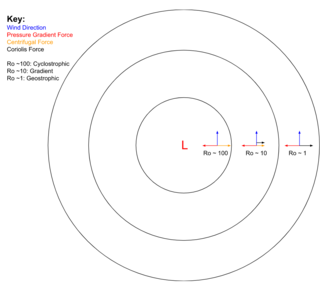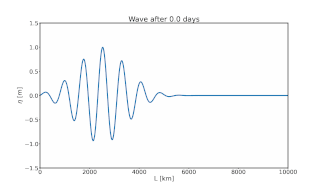Derivation of the single-layer QG equations
In Cartesian coordinates, the components of the geostrophic wind are
 (1a)
(1a) (1b)
(1b)
where  is the geopotential.
is the geopotential.
The geostrophic vorticity

can therefore be expressed in terms of the geopotential as
 (2)
(2)
Equation (2) can be used to find  from a known field
from a known field  . Alternatively, it can also be used to determine
. Alternatively, it can also be used to determine  from a known distribution of
from a known distribution of  by inverting the Laplacian operator.
by inverting the Laplacian operator.
The quasi-geostrophic vorticity equation can be obtained from the  and
and  components of the quasi-geostrophic momentum equation which can then be derived from the horizontal momentum equation
components of the quasi-geostrophic momentum equation which can then be derived from the horizontal momentum equation
 (3)
(3)
The material derivative in (3) is defined by
 (4)
(4)- where
 is the pressure change following the motion.
is the pressure change following the motion.
The horizontal velocity  can be separated into a geostrophic
can be separated into a geostrophic  and an ageostrophic
and an ageostrophic  part
part
 (5)
(5)
Two important assumptions of the quasi-geostrophic approximation are
- 1.
 , or, more precisely
, or, more precisely  .
. - 2. the beta-plane approximation
 with
with 
The second assumption justifies letting the Coriolis parameter have a constant value  in the geostrophic approximation and approximating its variation in the Coriolis force term by
in the geostrophic approximation and approximating its variation in the Coriolis force term by  . [4] However, because the acceleration following the motion, which is given in (1) as the difference between the Coriolis force and the pressure gradient force, depends on the departure of the actual wind from the geostrophic wind, it is not permissible to simply replace the velocity by its geostrophic velocity in the Coriolis term. [4] The acceleration in (3) can then be rewritten as
. [4] However, because the acceleration following the motion, which is given in (1) as the difference between the Coriolis force and the pressure gradient force, depends on the departure of the actual wind from the geostrophic wind, it is not permissible to simply replace the velocity by its geostrophic velocity in the Coriolis term. [4] The acceleration in (3) can then be rewritten as
 (6)
(6)
The approximate horizontal momentum equation thus has the form
 (7)
(7)
Expressing equation (7) in terms of its components,
 (8a)
(8a)
 (8b)
(8b)
Taking  , and noting that geostrophic wind is nondivergent (i.e.,
, and noting that geostrophic wind is nondivergent (i.e.,  ), the vorticity equation is
), the vorticity equation is
 (9)
(9)
Because  depends only on
depends only on  (i.e.,
(i.e.,  ) and that the divergence of the ageostrophic wind can be written in terms of
) and that the divergence of the ageostrophic wind can be written in terms of  based on the continuity equation
based on the continuity equation

equation (9) can therefore be written as
 (10)
(10)
The same identity using the quasi-geostrophic potential vorticity
Using the chain rule of differentiation, term C can be written as
 (15)
(15)
But based on the thermal wind relation,
 .
.
In other words, is perpendicular to
is perpendicular to  and the second term in equation (15) disappears.
and the second term in equation (15) disappears.
The first term can be combined with term B in equation (14) which, upon division by  can be expressed in the form of a conservation equation [6]
can be expressed in the form of a conservation equation [6]
 (16)
(16)
where  is the quasi-geostrophic potential vorticity defined by
is the quasi-geostrophic potential vorticity defined by
 (17)
(17)
The three terms of equation (17) are, from left to right, the geostrophic relative vorticity, the planetary vorticity and the stretching vorticity.
Implications
As an air parcel moves about in the atmosphere, its relative, planetary and stretching vorticities may change but equation (17) shows that the sum of the three must be conserved following the geostrophic motion.
Equation (17) can be used to find  from a known field
from a known field  . Alternatively, it can also be used to predict the evolution of the geopotential field given an initial distribution of
. Alternatively, it can also be used to predict the evolution of the geopotential field given an initial distribution of  and suitable boundary conditions by using an inversion process.
and suitable boundary conditions by using an inversion process.
More importantly, the quasi-geostrophic system reduces the five-variable primitive equations to a one-equation system where all variables such as  ,
,  and
and  can be obtained from
can be obtained from  or height
or height  .
.
Also, because  and
and  are both defined in terms of
are both defined in terms of  , the vorticity equation can be used to diagnose vertical motion provided that the fields of both
, the vorticity equation can be used to diagnose vertical motion provided that the fields of both  and
and  are known.
are known.


































































